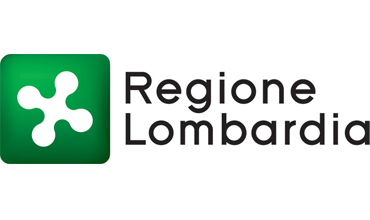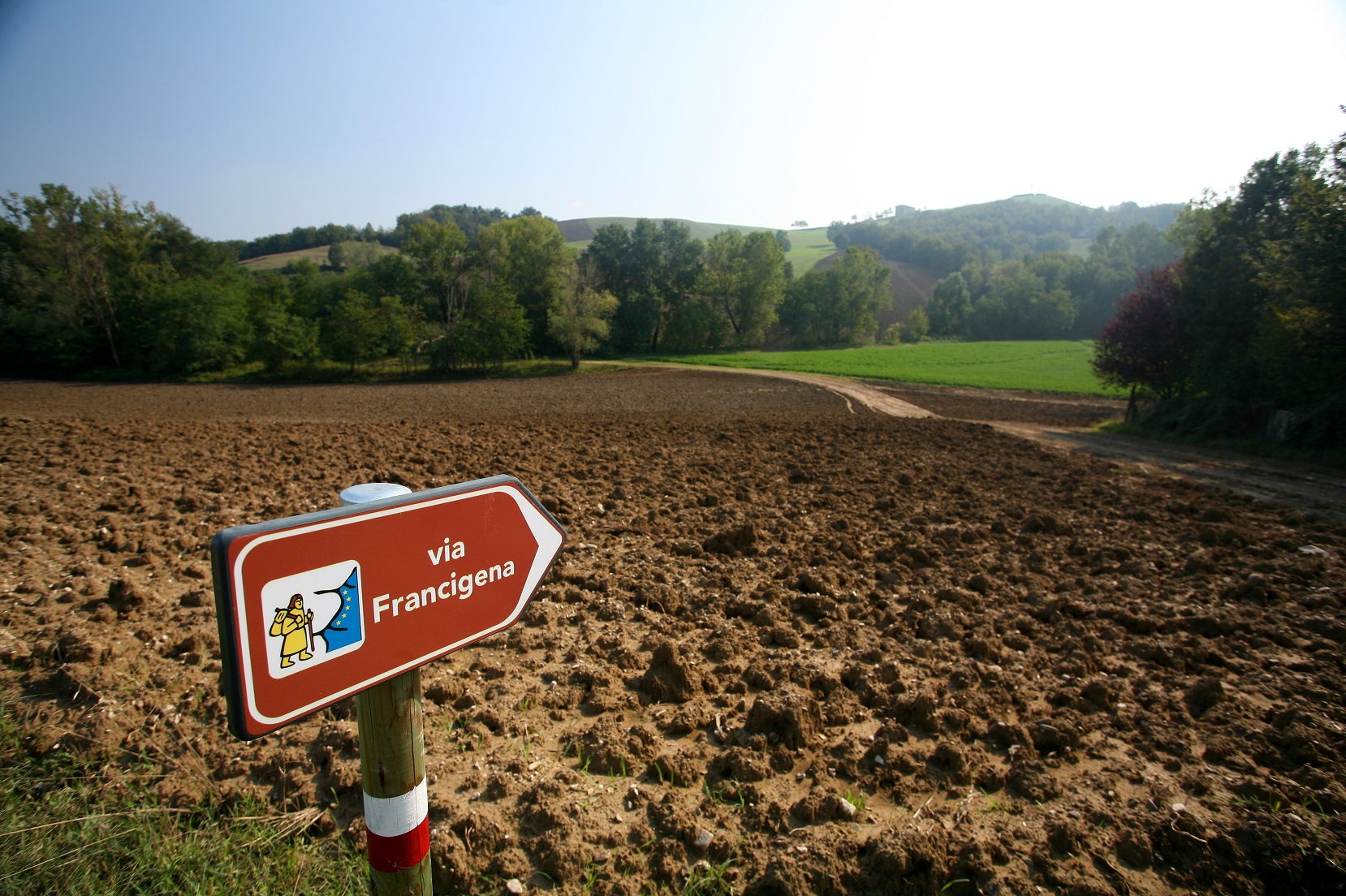A route that starts from Northern Europe to Rome: the "via Francigena " crosses Lombardy for 120 kilometers, along the Lomellina and the Lodi area following canals, rice fields and meadows and passing through the cities of Pavia and Lodi. The first part of the route, up to the confluence with the Ticino river, crosses the beautiful countryside of Pavia with its farmhouses and vegetations.
Historically, the "Via Francigena" was a long corridor connecting the northern territories of Europe to Rome, passing through the Alps. The road then continued towards southern Italy, where pilgrims embarked for the Holy Land.
ROBBIO (PV)
In the first stage in Lombardy, in Robbio, you can visit the Church of San Valeriano. The church was built by the Cluniac monks in the first century of the year one thousand. What we see today, however, is the result of subsequent works that finished around the year 1200 and later, after becoming a secular property, it was divided into two floors with an external access staircase and was used as a warehouse. Today the church is used for religious services, but the parts in poor condition are closed to the public.
For more information, please visit lombardiabeniculturali.it website
For information on accessibility, please click on this link
In Robbio there is another place that is worth a visit: the church of San Pietro that was built between 1125 and 1150 and renovated in 1960. It is a true jewel of Romanesque art, with its brick portal and frescoes, both on the apse and on the pillars, inspired by stories of the Gospel and the cult of the Saints.
Among the frescoes that deserve attention are: the Christ with the four evangelists and the "Santissima Trinità"(1507), represented with the three identical images of the Father, the Son and the Holy Spirit, as was often the case before the Council of Trento. There are many other sacred representations, which are the so-called "Bible of the poor": in fact this was how illiterate people were educated to Christianity.
For information on accessibility, please click on this link
MORTARA (PV)
In the town of Mortara, famous for its many churches and basilicas, we suggest to visit the Basilica of San Lorenzo, that is the cathedral of the city. Built between 1375 and 1380 in Lombard Gothic style, it is recognizable by its terracotta façade.
Inside it is possible to admire valuable works of art, in particular, the four chapels (two on each side) retain real masterpieces: on the right side, you can admire a fresco of the "Virgin Mary and Child " dating back to the fifteenth century and the " Virgin with the Rosary " (1578) by Bernardino Lanino ; on the left side, there is a wooden nativity scene with 80 low-relief figures by Lorenzo da Mortara (15th century).
For information on accessibility, please click on this link
Still in Mortara you can go and see the Abbey of Santa Croce that was founded, according to tradition, in 1080 outside the walls of the village at the behest of Pope Gregory VII and in 1596 was rebuilt within the city walls, designed by Pellegrino Tibaldi.
For information on accessibility, please click on this link
It is certainly worth visiting the Abbey of Sant'Albino dating back to the fifth century and renovated during the 1500s; according to tradition, it was also rebuilt by Charlemagne in 774, after a bloody battle won against the Longobards in this area.
Today of the original abbey remains the church, with the fifteenth-century frescoes and the elegant Renaissance portico, the Romanesque-Gothic bell tower, the remains of the cloister with the loggia in masonry and wooden architraves, and some rural buildings that were part of the former convent, now in ruins. Inside, in addition to the frescoes, there is a series of bricks bearing the traces of the passage of the pilgrims, which often stopped in Sant'Albino.
For information on accessibility, please click on this link
GARLASCO (PV)
Continuing to Pavia, at Garlasco there is the Sanctuary of the Madonna della Bozzola that is worth a visit. The sanctuary was built in the early 1500s and immediately became a destination for Christian pilgrimages. According to tradition, it was built in the place where, in 1465, there a miraculous apparition of the Virgin Mary, which was later immortalized on the high altar in a painting by Agostino da Pavia.
For information on accessibility, please click on this link
CERTOSA DI PAVIA (PV)
A few kilometers from the capital of the Lombard Kingdom, you can not miss a visit to the beautiful Certosa di Pavia, one of the greatest masterpieces of the Italian Renaissance that was built at the end of the fourteenth century by Gian Galeazzo Visconti, Duke of Milan and completed only two centuries later by the Sforza family. The visit includes: the Church of Santa Maria delle Grazie, the "Chiostro Piccolo" and the "Chiostro Grande".
While visiting the Certosa, one is immediately welcomed by the splendid vestibule that leads to the internal courtyard, with the decorated vault of the entrance, the marble door sculpted with medallions of Gian Galeazzo Visconti and Filippo Maria Visconti and, on the right-hand wall, the Saints Cristoforo and Sebastiano painted by Bernardino Luini at the end of the fifteenth century.
You can not miss a visit to the church, dedicated to the Madonna delle Grazie and to the Palazzo Ducale.
The interior of the church, a Latin cross with three naves, is covered with cross vaults and characterized by pictorial decorations by Bergognone. Among the extraordinary works of art you can admire the funeral monument of Ludovico il Moro and Beatrice d'Este by Cristoforo Solari.
The Palazzo Ducale was the summer residence of the Visconti and later of the Sforza family, while today it hosts the Museo della Certosa.
For information on accessibility, please click on this link
At this link you can download a guide of the Certosa.
For information on the accessibility of the Certosa, please visit this link
Before leaving the Certosa, we recommend a visit to the ancient Pharmacy, located to the left of the courtyard, with many specialties produced by Trappist monks, such as Amaro Certosa, Amaro Centerbe, coffee liqueur or the yellow and green Gran Certosa, the "Gocce Imperiali della Certosa", products based on honey, chocolate and medicinal herbs. As is the tradition of various monastic orders, the Cistercians who live in the Abbey dedicate themselves to the restoration of books and have a bookbinding laboratory.
PAVIA
Cathedral of Pavia
With its 97 meters high octagonal dome, the Cathedral of Pavia can be seen throughout the surrounding countryside. Resulting from a centuries-old stratification, the Cathedral, as we see it today, was started in 1488 and built over the twin Romanesque churches of S. Stefano and S. Maria del Popolo, whose structures can still be admired in the crypts. The building, whose architectural structure is by Bramante, developed over a period of 400 years: the completion of the church and the completion of the works, in fact, date back to the beginning of the twentieth century.
In the crypt of the Cathedral of Pavia the remains of S. Siro are preserved in a precious seventeenth-century silver and crystal reliquary. Siro was the first bishop and patron of the city. The Corinthian capitals are the proofs of the different eras of construction, from the late fifteenth century (the choir) to the late nineteenth century (the western spans).
For information on accessibility, please click on this link
Immediately beyond the old town, is the Basilica of San Pietro in Ciel d'Oro, one of the most important medieval religious monuments of Pavia. On its façade carved in a plaque there is a triplet from the Paradise by Dante Alighieri referring to the burial of the Roman philosopher Severino Boezio, killed in the basilica by the Ostrogothic king Teodorico and on whose tomb, according to tradition, this Paleochristian Basilica was built.
In the Basilica you can also admire the "Arca di Sant'Agostino", in which the remains of the Saint are preserved: this is a masterpiece of bas-reliefs and marble statues sculpted by the masters of Como in the fourteenth century.
For more information, you can visit the website of the Basilica.
For information on accessibility, please click on this link
The last Lombard stretch of the Via Francigena crosses the territory around Lodi, from the "Ponte di Mariotto" along the Lambro river, where the route first follows the bank of the river and then the paddy fields up to Orio Litta. From there you reach the "Guado di Sigerico", better known as the "Transitum Padi" (Po Passage), in the municipality of Senna Lodigiana. That stretch crosses the Po river and leads the pilgrims of yesterday and today from Corte Sant'Andrea to Soprarivo of Calendasco, on the Emilian banks of the river.
Before leaving
On this website you can view and download maps and GPS tracks of the official path - that can be made on foot and by bicycle - and the main connections with Milan. Furthermore, here you can download the App for iPhone and Android, which allows the GPS navigation along the entire route of the Via Francigena from the Colle del Gran San Bernardo to Rome: more than 1000 km divided into 45 stages. The maps and the descriptions of the stages can be preloaded on your smartphone and be used even without internet connection.
"Project carried out under the General program of intervention of the Lombardy Region, funded by the Ministry of Economic Development - 2015 Allocation".

